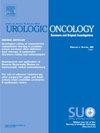PREDICTIVE VALUE OF PSA KINETICS ON RISK OF PROSTATE CANCER VERSUS INFLAMMATION IN AN AFRO-CARIBBEAN POPULATION: A SINGLE INSTITUTION BASED RETROSPECTIVE STUDY IN AFRO-CARIBBEAN POPULATION
IF 2.4
3区 医学
Q3 ONCOLOGY
Urologic Oncology-seminars and Original Investigations
Pub Date : 2025-03-01
DOI:10.1016/j.urolonc.2024.12.077
引用次数: 0
Abstract
Introduction
The change in Prostate Specific Antigen (PSA) over time, known as PSA velocity (PSAV), has been proposed as a measurement for improving the specificity of PSA monitoring for prostate cancer screening; however, its utility is controversial. Some studies use PSA doubling time (PSADT) as a readout of biochemical and clinical progression. Studies suggest that the validity of PSAV thresholds varies depending on the demographics of the patient population. Few studies investigate how PSAV and PSADT can be used to stratify prostate cancer risk in black populations. Black men have the highest incidence of prostate cancer out of any group in America. This retrospective study aims to compare PSAV and PSADT in patients who received prostate biopsy with pathology results of inflammation versus cancer to determine how PSAV and PSADT impact the risk of prostate cancer in a predominantly Afro-Caribbean patient population.
Methods
Prostate biopsies from Kings County Hospital, Brooklyn, New York, from 01/2018 to 04/2024, were retrospectively reviewed and recorded in the REDcap database. Patients with three PSA values at least 18 months, with six months between each, were included. Pathology results were classified into cancer (N=155) and inflammation (N=70). The cancer cohort was stratified to adjust for treatment (N=126, 81%). PSAV calculation used untransformed PSA values that met the previously mentioned inclusion criteria. The cancer cohort (calculated before treatment, N=50) was compared to the inflammation group (N=64). PSA doubling times (at least two PSA values, three months apart) were also compared between the cancer cohort pre- and post-treatment (N = 68, 63) and the inflammation cohort pre- and post-biopsy (N = 34, 39) when PSAV could not be calculated. Odds ratio, sensitivity, and specificity were calculated using several PSAV and doubling time thresholds.
Results
Increasing threshold PSAV increased specificity in identifying a cancer patient (Figure 1). However, returns were limited as using a PSAV threshold of 2.00 ng/mL/Yr, 16 of 50 (32%) cancer patients met the threshold. This contrasts with 36 of 50 patients (72%) who met the lowest threshold. 0.65 ng/mL/Yr yielded the highest odds ratio (OR = 3.97, 95% CI [1.81, 8.71]) amongst results where p < 0.05. When comparing PSA doubling time using values of less than 6 and 10 months as thresholds between pre-treatment cancer and pre-biopsy groups, there were no significant findings. However, comparing post-treatment cancer cohort to post-biopsy inflammation, both a cutoff of 6 (OR = 3.33, 95% CI [1.44, 7.67]) and 10 months (OR = 3.44, 95% CI [1.49, 7.93]) showed similar significant findings (Table 1).
Conclusions
PSAV has the potential to increase the specificity of PSA monitoring, particularly in black populations that have a high incidence of disease. Our data suggests that when taken together with PSA value, PSAV can improve the specificity of PSA monitoring in an Afro-Caribbean population. PSADT may be helpful in the decision to perform or repeat a prostate biopsy if the initial biopsy showed inflammation in this patient population. However, our research suggests that PSADT does not help estimate the risk of cancer in individuals who have never received a biopsy.
psa动力学对非裔加勒比人群前列腺癌与炎症风险的预测价值:一项基于单一机构的非裔加勒比人群回顾性研究
前列腺特异性抗原(PSA)随时间的变化,被称为PSA速度(PSAV),已被提出作为提高PSA监测前列腺癌筛查特异性的测量方法;然而,它的效用是有争议的。一些研究使用PSA倍增时间(PSADT)作为生化和临床进展的读数。研究表明,PSAV阈值的有效性取决于患者人群的人口统计数据。很少有研究调查PSAV和PSADT如何用于黑人人群前列腺癌风险的分层。在美国,黑人男性的前列腺癌发病率是最高的。这项回顾性研究的目的是比较PSAV和PSADT在接受前列腺活检的患者中与炎症和癌症的病理结果相比较,以确定PSAV和PSADT如何影响主要是非裔加勒比患者人群中前列腺癌的风险。方法回顾性分析2018年1月至2024年4月在纽约布鲁克林国王县医院进行的前列腺活检,并将其记录在REDcap数据库中。患者三个PSA值至少18个月,每六个月之间,包括。病理结果分为癌(N=155)和炎症(N=70)。对癌症队列进行分层以调整治疗(N=126, 81%)。PSAV计算使用未转换的PSA值,满足前面提到的纳入标准。癌症组(治疗前计算,N=50)与炎症组(N=64)进行比较。在无法计算PSAV的情况下,还比较了癌症组治疗前后(N = 68,63)和炎症组活检前后(N = 34,39)的PSA加倍次数(至少两次PSA值,间隔三个月)。比值比、敏感性和特异性使用几个PSAV和倍增时间阈值计算。增加PSAV阈值增加了识别癌症患者的特异性(图1)。然而,使用2.00 ng/mL/Yr的PSAV阈值,50例癌症患者中有16例(32%)达到阈值,结果受到限制。50例患者中有36例(72%)达到最低阈值。0.65 ng/mL/Yr的比值比最高(OR = 3.97,95% CI [1.81, 8.71]), p <;0.05. 当使用小于6个月和10个月的值作为治疗前癌症组和活检前组之间PSA加倍时间的阈值进行比较时,没有明显的发现。然而,将治疗后的癌症队列与活检后的炎症进行比较,截断值为6 (OR = 3.33,95% CI[1.44, 7.67])和10个月(OR = 3.44,95% CI[1.49, 7.93])均显示出类似的显著发现(表1)。结论spsav有可能增加PSA监测的特异性,特别是在疾病发病率高的黑人人群中。我们的数据表明,当与PSA值一起使用时,PSAV可以提高非裔加勒比人群PSA监测的特异性。如果在该患者群体中,最初的活检显示有炎症,PSADT可能有助于决定是否进行或重复前列腺活检。然而,我们的研究表明,PSADT不能帮助估计从未接受过活组织检查的人患癌症的风险。
本文章由计算机程序翻译,如有差异,请以英文原文为准。
求助全文
约1分钟内获得全文
求助全文
来源期刊
CiteScore
4.80
自引率
3.70%
发文量
297
审稿时长
7.6 weeks
期刊介绍:
Urologic Oncology: Seminars and Original Investigations is the official journal of the Society of Urologic Oncology. The journal publishes practical, timely, and relevant clinical and basic science research articles which address any aspect of urologic oncology. Each issue comprises original research, news and topics, survey articles providing short commentaries on other important articles in the urologic oncology literature, and reviews including an in-depth Seminar examining a specific clinical dilemma. The journal periodically publishes supplement issues devoted to areas of current interest to the urologic oncology community. Articles published are of interest to researchers and the clinicians involved in the practice of urologic oncology including urologists, oncologists, and radiologists.

 求助内容:
求助内容: 应助结果提醒方式:
应助结果提醒方式:


